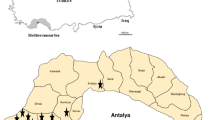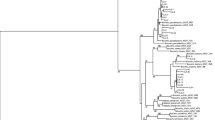Abstract
Although Turkey is the first among all hazelnut-producing countries, yield per unit area of this crop is low in comparison to other countries, mainly because many insect species seriously damage hazelnut trees and their fruit. To find effective and safe biocontrol agents, we conducted a survey study to isolate entomopathogenic fungi from the hazelnut-growing region of Turkey and characterized the isolated strains in detail. In addition, we determined the effectiveness of seven selected strains from this region against Melolontha melolontha (Coleoptera: Scarabaeidae) which is one of the most serious pests of hazelnut. In 2006 and 2007, 301 soil samples were collected randomly and analyzed for presence of entomopathogenic fungi using the Galleria bait method. Entomopathogenic fungi were found to occur in 20.59% of the soil samples studied. Based on morphology, ITS sequence and partial sequencing of the 18S (SSU rDNA) and EF1-α genes, the isolates were identified as Metarhizium anisopliae var. anisopliae, Metarhizium sp., Beauveria bassiana, Beauveria cf. bassiana, Isaria fumosorosea and Evlachovaea sp. Metarhizium anisopliae var. anisopliae was isolated from 34 sites and was the most frequent and abundant entomopathogenic species recovered. All the isolates tested were pathogenic to M. melolontha. M. anisopliae var. anisopliae KTU-27 and Evlachovaea sp. KTU-36 produced the highest insecticidal activity (86.6%) within 15 days after inoculation. Our results suggest that entomopathogenic fungi could be good biocontrol agents against M. melolontha, and are discussed with respect to ecology of fungi in relation to habitat in order to evaluate biocontrol potential of these isolates. This is the first study of the distribution of entomopathogenic fungi in the hazelnut-growing region of Turkey and of their pathogenicities against M. melolontha.






Similar content being viewed by others
Abbreviations
- 18S (SSU rDNA):
-
18S small-subunit ribosomal DNA
- ARSEF:
-
USDA-ARS collection of entomopathogenic fungal cultures
- bp:
-
Base pair
- Bt:
-
Bacillus thuringiensis
- CBC:
-
Conservation biological control
- DNA:
-
Deoxyribonucleic acid
- dNTP:
-
Deoxyribonucleotide triphosphate
- EF1-α:
-
Elongation factor 1-alpha
- GBM:
-
Galleria bait method
- ha:
-
Hectare
- ITS1-5.8S-ITS2:
-
Internal transcribed spacer1-5.8S-internal transcribed spacer2
- L/W:
-
Length/width
- min:
-
Minute
- NCBI:
-
The National Center for Biotechnology Information
- NY:
-
New York
- PCR:
-
Polymerase chain reaction
- PDB:
-
Potato dextrose broth
- SDAY:
-
Sabouraud dextrose agar medium with 1% yeast extract
- USA:
-
The United States of America
- USDA-ARS:
-
United States Department of Agriculture-Agricultural Research Service
- UV:
-
Ultraviolet
- VIB:
-
The Flanders Institute for Biotechnology
References
Abbott WS (1925) A method of computing the effectiveness of an insecticide. J Econ Entomol 18:265–267
AliNiazee MT (1998) Ecology and management of hazelnut pests. Annu Rev Entomol 43:395–419
Ali-Shtayeh MS, Abdel-Basit M, Jamous R (2002) Distribution, occurrence and characterization of entomopathogenic fungi in agricultural soil in the Palestinian area. Mycopathologia 156:235–244
Bidochka MJ, Kamp AM, Lavender TM, Dekoning J, De Croos JNA (2001) Habitat association in two genetic groups of the insect-pathogenic fungus Metarhizium anisopliae: uncovering cryptic species? Appl Environ Microbiol 67:1335–1342
Bidochka MJ, Menzies FV, Kamp AM (2002) Genetic groups of the insect-pathogenic fungus Beauveria bassiana are associated with habitat and thermal growth preferences. Arch Microbiol 178:531–537
Bischoff JF, Rehner SA, Humber RA (2006) Metarhizium frigidum sp. nov.: a cryptic species of M. anisopliae and a member of the M. flavoviride complex. Mycologia 98:737–745
Borisov BA, Tarasov KL (1999) Notes on biodiversity of causal agents of invertebrate mycosiss in Adjaria (Southwestern Georgia). I. Evlachovaea kintrischica gen et sp. nov. (Hyphomycetes) from Kintrishi Reservation. Micologiya i Fitopatologiya 33:248–256 (in Russian)
Brownbridge M, Humber RA, Parker BL, Skinner M (1993) Fungal entomopathogens recovered from Vermont forest soils. Mycologia 85:358–361
Bustillo AE, Bernal MG, Benavides P, Chaves B (1999) Dynamics of Beauveria bassiana and Metarhizium anisopliae infecting Hypothenemus hampei (Coleoptera: Scolytidae) populations emerging from fallen coffee berries. Fla Entomol 82:491–498
Chandler D, Hay D, Reid AP (1997) Sampling and occurrence of entomopathogenic fungi and nematodes in UK soils. Appl Soil Ecol 5:133–141
Dolci P, Guglielmo F, Secchi F, Ozino OI (2006) Persistence and efficacy of Beauveria brongniartii strains applied as biocontrol agents against Melolontha melolontha in the Valley of Aosta (northwest Italy). J Appl Microbiol 100:1063–1072
Driver F, Milner RJ, Trueman JWH (2000) A taxonomic revision of Metarhizium based on a phylogenetic analysis of rDNA sequence data. Mycol Res 104:134–150
Gulsar Banu J, Subahasan K, Iyer R (2004) Occurrence and distribution of entomopathogenic nematodes in white grub endemic areas of Kerala. J Plant Crops 32:333–334
Hall TA (1999) BioEdit: a user-friendly biological sequence alignment editor and analysis program for Windows 95/98/NT. Nucl Acids Symp 41:95–98
Humber R (1997) Fungi: identification. In: Lacey LA (ed) Manual of techniques in insect pathology. Academic Press, San Diego, pp 153–185
Jackson TA, Alves SB, Pereira RM (2000) Success in biological control of soil-dwelling insects by pathogens and nematodes. In: Gurr G, Wratten S (eds) Biological control: measures of success. Academic Press, London, pp 271–296
Keller S, Zimmerman G (1989) Mycopathogens of soil insects. In: Wilding N, Collins NM, Hammond PM, Webber JF (eds) Insect-fungus interactions. Academic Press, London, pp 239–270
Keller S, Schweizer C, Keller E, Brenner H (1997) Control of white grubs (Melolontha melolontha L.) by treating adults with the fungus Beauveria brongniartii. Biocont Sci Technol 7:105–116
Keller S, Kessler P, Schweizer C (2003) Distribution of insect pathogenic fungi in Switzerland with special reference to Beauveria brongniartii and Metarhizium anisopliae. BioControl 48:307–319
Klingen I, Eilenberg J, Meadow R (2002) Impact of farming systems, field margins and bait insect on the findings of insect pathogenic fungi in soil. Agric Ecosys Environ 91:191–198
Luangsa-ard JJ, Hywel-Jones NL, Manoch L, Samson RA (2005) On the relationships of Paecilomyces sect. Isarioidea species. Mycol Res 109:581–589
Luz C, Rocha LFN, Humber RA (2003) Record of Evlachovaea sp on Triatoma sordida in the State of Goiás, Brazil, and its activity against Triatoma infestans. J Med Entomol 40:451–454
Meyling NV, Eilenberg J (2006) Occurrence and distribution of soil borne entomopathogenic fungi within a single organic agroecosystem. Agric Ecosys Environ 113:336–341
Meyling NV, Eilenberg J (2007) Ecology of the entomopathogenic fungi Beauveria bassiana and Metarhizium anisopliae in temperate agroecosystems: potential for conservation biological control. Biol Cont 43:145–155
Meyling NV, Rehner SA, Lübeck M, Buckley EP, Eilenberg J (2005) Multiple genetic lineages coexist sympatrically within a local population of Beauveria bassiana s.l. In: Proceedings of the 38th annual meeting of the society for invertebrate pathology, Anchorage, AK, USA, 7–11 August 2005, p 61
Paparatti B, Speranza S (1999) Biological control of chestnut weevil (Curculio elephans Gyll.; Coleoptera, Curculionidae) with the entomopathogenic fungus Beauveria bassiana (Balsamo) Vuill. (Deuteromycotina, Hyphomycetes). In: Salesses G (ed) II International symposium on chestnut, Bordeaux, Acta Hort, vol 494, pp 459–464
Paparatti B, Speranza S (2005) Biological control of hazelnut weevil (Curculio nucum L., Coleoptera, Curculionidae) using the entomopathogenic fungus Beauveria bassiana (Balsamo) Vuill. (Deuteromycotina, Hyphomycetes). In: Tous J, Rovira M, Romero A (eds) VI International symposium on hazelnut, Tarragona-Reus, Acta Hort, vol 686, pp 407–412
Rehner SA, Buckley E (2005) A Beauveria phylogeny inferred from nuclear ITS and EF1-α sequences: evidence for cryptic diversification and links to Cordyceps teleomorphs. Mycologia 97:84–98
Sezen K, Demirbag Z (2006) A new isolate of Melolontha melolontha entomopoxvirus in Turkey: morphology, infectivity and prevalence in the field. Appl Entomol Zool 41:471–477
Sezen K, Demir İ, Demirbağ Z (2007) Identification and pathogenicity of entomopathogenic bacteria from common cockcfer, Melolontha melolontha (Coleoptera: Scarabaeidae). New Zeal J Crop Hort 35:79–85
Torres MS, White JF, Bischoff JF (2005) Cordyceps spegazzinii sp. nov., a new species of the C. militaris group. Mycotaxon 94:253–263
Tuncer C, Ecevit O (1997) Current status of hazelnut pests in Turkey. In: Köksal AI, Okay Y, Güsnes NT (eds) IV International symposium on hazelnut, Ordu. Acta Hort, vol 445, pp 545–552
Van de Peer Y, De Wachter R (1994) TREECON for Windows: a software package for the construction and drawing of evolutionary trees for the Microsoft Windows environment. Comput Appl Biosci 10:569–570
Vanninen I (1995) Distribution and occurrence of four entomopathogenic fungi in Finland: effect of geographical location, habitat type and soil type. Mycol Res 100:93–101
White TJ, Bruns T, Lee S, Taylor J (1990) Amplification and direct sequencing of fungal ribosomal RNA genes for phylogenetics. In: Innis MA, Gelfand DH, Sninsky JJ, White TJ (eds) PCR protocols: a guide to methods and applications. Academic Press, San Diego, pp 315–322
Woodring JL, Kaya HK (1988) Steinernematid and heterorhabditid nematodes: a handbook of biology and techniques. Arkansas Agricultural Experiment Station, Fayetteville
Zimmermann G (1986) The “Galleria bait method” for detection of entomopathogenic fungi in soil. Z Angew Entomol 102:213–215
Zimmmermann G (1993) The entomopathogenic fungus Metarhizium anisopliae and its potential as a biocontrol agent. Pestic Sci 37:375–379
Acknowledgement
We would like to thank Dr. Ayhan Gökçe for his kind help with the morphological characterizations of these fungi.
Author information
Authors and Affiliations
Corresponding author
Additional information
Handling Editor: Helen Roy
Rights and permissions
About this article
Cite this article
Sevim, A., Demir, I., Höfte, M. et al. Isolation and characterization of entomopathogenic fungi from hazelnut-growing region of Turkey. BioControl 55, 279–297 (2010). https://doi.org/10.1007/s10526-009-9235-8
Received:
Accepted:
Published:
Issue Date:
DOI: https://doi.org/10.1007/s10526-009-9235-8




